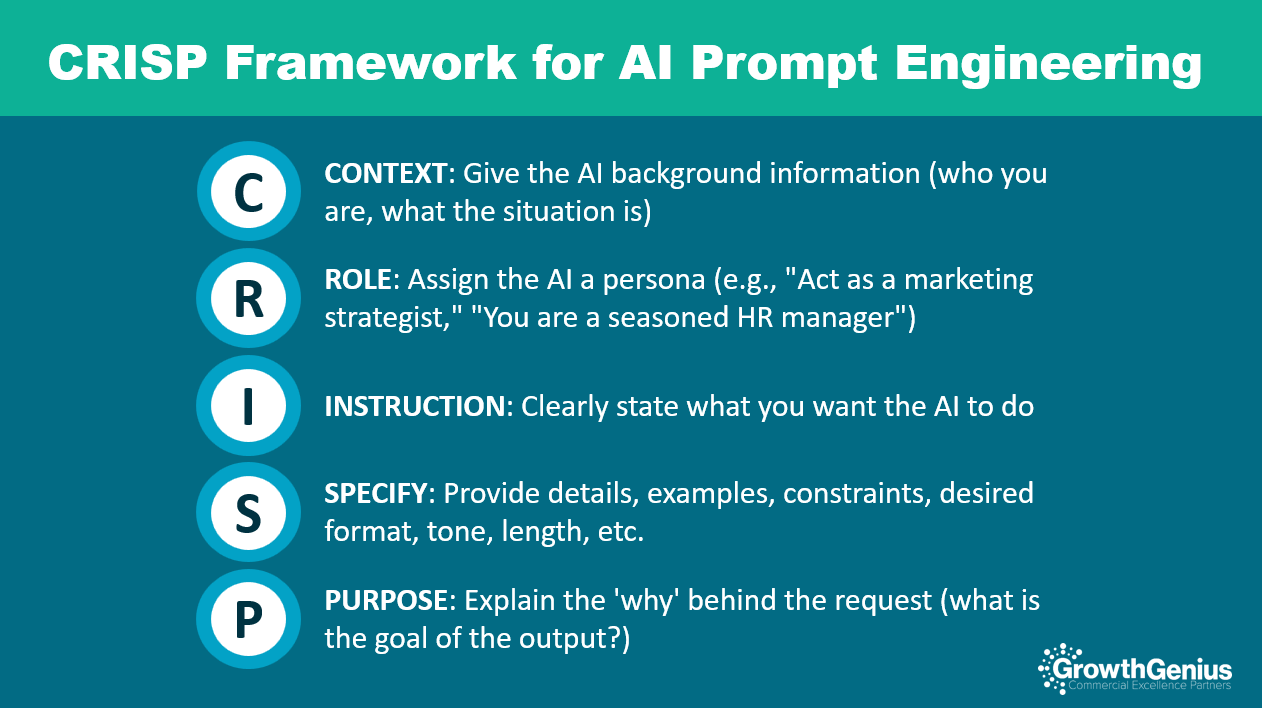Unlock AI's Full Potential: A Lean Approach to Prompt Engineering
In today's fast-paced business world, Artificial Intelligence (AI) is no longer a futuristic concept; it's a powerful tool for driving efficiency, innovation, and commercial excellence. But just like any sophisticated tool, the output you get from AI is only as good as the input you provide. This is where prompt engineering comes in – the art and science of crafting effective instructions for AI. Prompt engineering is the practice of strategically structuring text inputs to get the most useful and accurate outputs from a large language model.
At the heart of our consulting philosophy is Lean thinking: creating more value with less work by systematically eliminating waste and continuously improving processes. We believe these same principles are crucial for successful AI integration. One of the most effective models for this is the CRISP framework, a powerful and distinctly Lean approach to interacting with AI that ensures clarity, reduces rework and waste, and drives meaningful results. CRISP is an easy-to-remember acronym for context, role, instruction, specificity, and purpose. Including all of these in your AI prompts will help you to get optimal AI outputs.
CRISP Framework for Prompt Engineering
C – Context: Setting the Stage for Success
Just as Lean emphasizes understanding the entire value stream, providing Context gives your AI the necessary background information to understand the situation fully. Who is the audience? What’s the industry? What historical data or prior conversations are relevant?
Lean Connection: This is akin to "Go to Gemba" – truly understanding the place where value is created. By providing rich context, you eliminate the "waste" of the AI making assumptions or generating irrelevant outputs, leading to more precise and valuable responses from the outset.
R – Role: Defining the AI's Persona
In Lean, defining roles and responsibilities is key to a smooth process. Similarly, assigning a clear Role to your AI instructs it on the persona it should adopt. Should it be a marketing expert, a technical writer, a supportive coach, or a critical editor?
Lean Connection: This ensures the AI's output is perfectly aligned with the desired tone, style, and perspective. It's about empowering the AI to perform its "job" with precision, much like a well-trained team member.
I – Instruction: Clear, Concise, and Actionable
The core of any process is clear instructions. Your Instructions should be direct, unambiguous, and specify exactly what you want the AI to do. Use action verbs and break down complex tasks into smaller steps if necessary.
Lean Connection: This directly tackles "over-processing" and "waiting." Clear instructions prevent the need for multiple iterations to get to the desired output. It's about providing the exact specifications for the "product" you want, minimizing wasted effort.
S – Specificity: Details That Drive Accuracy
Lean focuses on standardization and reducing variability. Specificity in your prompt means including all the necessary details, constraints, examples, and formatting requirements. What should be included? What should be excluded? What's the desired length or format?
Lean Connection: This eliminates the "waste" of correction and rework. By being specific, you guide the AI towards the precise outcome, reducing "defects" and ensuring the first-time-right approach that Lean advocates for. Examples act as "standard work" for the AI.
P – Purpose: Understanding the 'Why' Behind the 'What'
Finally, and crucially for commercial excellence, understanding the Purpose behind your request transforms AI from a task-doer into a strategic partner. What is the ultimate goal of this output? How will it be used? What business objective does it serve?
Lean Connection: This is about delivering "value" to the customer (or the end-user of the AI's output). By clarifying the purpose, you enable the AI to generate responses that are not just technically correct, but strategically aligned and truly impactful for your commercial goals. It helps the AI understand the value it needs to create.
By applying the CRISP framework, you're not just writing better prompts; you're applying Lean principles to your AI interactions. This structured approach helps eliminate the waste of ambiguity, rework, and misalignment, ultimately driving greater efficiency, higher quality outputs, and commercial excellence in your organization.
Ready to level up your AI skills?
Join our upcoming AI-Powered Lean Leadership Sprint—a 4-week live (and on-demand) program designed for modern leaders who want to strategically harness AI and Lean principles. You’ll learn how to optimize your personal workflows, drive continuous improvement across your team, and confidently prepare for the future of AI.
Unlock your competitive edge with AI and Lean. This is your chance to master the tools that will define tomorrow’s leaders.
Register now for our next Session starting October 13, 2025 - spaces are limited!

